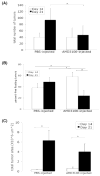SDF1/CXCL12 is involved in recruitment of stem-like progenitor cells to orthotopic murine malignant mesothelioma spheroids
- PMID: 20651364
- PMCID: PMC3641861
SDF1/CXCL12 is involved in recruitment of stem-like progenitor cells to orthotopic murine malignant mesothelioma spheroids
Abstract
Background/aim: Tumor progression is influenced by the microenvironment. We found stem cells are recruited to malignant mesothelioma spheroids. We aimed to determine if stem cell recruitment depends on the chemokine SDF1, and if inhibition of the cognate receptor CXCR4 affects tumor growth.
Materials and methods: The kinetics of stem cell recruitment was determined using immunofluorescence staining, BrdU incorporation and eGFP transgenic mice. Chemokines were identified using PCR array. Inhibitors of CXCR4 were used to determine the effect on cell migration and tumor progression.
Results: The increasing number of stem cells found in tumor spheroids over time is attributed to cell recruitment. Stem cell migration in vitro was enhanced by exogenous SDF1 and abrogated by CXCR4 inhibition and. CXCR4 inhibition reduced tumor burden in vivo.
Conclusion: SDF1 is a candidate chemokine for recruitment of stem cells to malignant peritoneal mesothelioma and a potential target for therapy.
Figures






Similar articles
-
Bone-derived Nestin-positive mesenchymal stem cells improve cardiac function via recruiting cardiac endothelial cells after myocardial infarction.Stem Cell Res Ther. 2019 Apr 27;10(1):127. doi: 10.1186/s13287-019-1217-x. Stem Cell Res Ther. 2019. PMID: 31029167 Free PMC article.
-
A critical role of Src family kinase in SDF-1/CXCR4-mediated bone-marrow progenitor cell recruitment to the ischemic heart.J Mol Cell Cardiol. 2015 Apr;81:49-53. doi: 10.1016/j.yjmcc.2015.01.024. Epub 2015 Feb 3. J Mol Cell Cardiol. 2015. PMID: 25655934 Free PMC article.
-
Misregulation of SDF1-CXCR4 signaling impairs early cardiac neural crest cell migration leading to conotruncal defects.Circ Res. 2013 Aug 16;113(5):505-16. doi: 10.1161/CIRCRESAHA.113.301333. Epub 2013 Jul 9. Circ Res. 2013. PMID: 23838132
-
Dissecting the role of the CXCL12/CXCR4 axis in acute myeloid leukaemia.Br J Haematol. 2020 Jun;189(5):815-825. doi: 10.1111/bjh.16456. Epub 2020 Mar 5. Br J Haematol. 2020. PMID: 32135579 Review.
-
CXCL12/CXCR4 signaling in malignant brain tumors: a potential pharmacological therapeutic target.Brain Tumor Pathol. 2011 Apr;28(2):89-97. doi: 10.1007/s10014-010-0013-1. Epub 2011 Jan 6. Brain Tumor Pathol. 2011. PMID: 21210239 Review.
Cited by
-
Targeting the CXCR4/CXCL12 axis in treating epithelial ovarian cancer.Gene Ther. 2017 Oct;24(10):621-629. doi: 10.1038/gt.2017.69. Epub 2017 Sep 7. Gene Ther. 2017. PMID: 28753202
-
Mesothelioma Malignancy and the Microenvironment: Molecular Mechanisms.Cancers (Basel). 2021 Nov 12;13(22):5664. doi: 10.3390/cancers13225664. Cancers (Basel). 2021. PMID: 34830817 Free PMC article. Review.
-
Inhibitors of HIF-1α and CXCR4 Mitigate the Development of Radiation Necrosis in Mouse Brain.Int J Radiat Oncol Biol Phys. 2018 Mar 15;100(4):1016-1025. doi: 10.1016/j.ijrobp.2017.12.257. Epub 2017 Dec 21. Int J Radiat Oncol Biol Phys. 2018. PMID: 29485043 Free PMC article.
-
Imaging CXCL12-CXCR4 signaling in ovarian cancer therapy.PLoS One. 2013;8(1):e51500. doi: 10.1371/journal.pone.0051500. Epub 2013 Jan 23. PLoS One. 2013. PMID: 23372646 Free PMC article.
-
The role of the cell-cell interactions in cancer progression.J Cell Mol Med. 2015 Feb;19(2):283-96. doi: 10.1111/jcmm.12408. Epub 2015 Jan 19. J Cell Mol Med. 2015. PMID: 25598217 Free PMC article. Review.
References
-
- Zervos MD, Bizekis C, Pass HI. Malignant mesothelioma. Current Opinion in Pulmonary Medicine. 2008;14:303–309. - PubMed
-
- Nagy JA, Herzberg KT, Dvorak JM, et al. Pathogenesis of malignant ascites formation: initiating events that lead to fluid accumulation. Cancer Research. 1993;53:2631–2643. - PubMed
-
- Shield K, Acklan ML, Ahmed N, et al. Multicellular spheroids in ovarian cancer metastases: Biology and pathology. Gynecologic Oncology. 2008 - PubMed
-
- Sangai T, Ishii G, Kodama K, et al. Effect of differences in cancer cells and tumor growth sites on recruiting bone marrow-derived endothelial cells and myofibroblasts in cancer-induced stroma. Int J Cancer. 2005;115(6):885–892. - PubMed
Publication types
MeSH terms
Substances
Grants and funding
LinkOut - more resources
Full Text Sources
Medical
